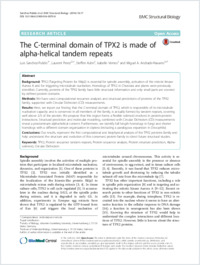The C-terminal domain of TPX2 is made of alpha-helical tandem repeats
- Sanchez-Pulido, Luis MRC Human Genetics Unit, Institute of Genetics and Molecular Medicine, The University of Edinburgh, Western General Hospital, Crewe Road, Edinburgh EH4 2XU, UK
- Perez, Laurent Center for Genomic Regulation, C/ Dr Aiguader 88, 08003 Barcelona, Spain - Institute for Research in Biomedicine (IRB), Faculty of Biomedical Sciences, Università della Svizzera italiana, Switzerland
- Kuhn, Steffen Faculty of Biology, Johannes-Gutenberg University, Gresemundweg 2, 55128 Mainz, Germany
- Vernos, Isabelle Center for Genomic Regulation, C/ Dr Aiguader 88, 08003 Barcelona, Spain
- Andrade-Navarro, Miguel A. Faculty of Biology, Johannes-Gutenberg University, Gresemundweg 2, 55128 Mainz, Germany - Institute of Molecular Biology, Ackermannweg 4, 55128 Mainz, Germany
-
26.10.2016
Published in:
- BMC structural biology. - 2016, vol. 16, p. 17
TPX2
Protein sequence tandem repeats
Protein sequence analysis
Protein structure prediction
Alpha-solenoid
Circular Dichroism
English
Background: TPX2 (Targeting Protein for Xklp2) is essential for spindle assembly, activation of the mitotic kinase Aurora A and for triggering microtubule nucleation. Homologs of TPX2 in Chordata and plants were previously identified. Currently, proteins of the TPX2 family have little structural information and only small parts are covered by defined protein domains. Methods: We have used computational sequence analyses and structural predictions of proteins of the TPX2 family, supported with Circular Dichroism (CD) measurements. Results: Here, we report our finding that the C-terminal domain of TPX2, which is responsible of its microtubule nucleation capacity and is conserved in all members of the family, is actually formed by tandem repeats, covering well above 2/3 of the protein. We propose that this region forms a flexible solenoid involved in protein-protein interactions. Structural prediction and molecular modeling, combined with Circular Dichroism (CD) measurements reveal a predominant alpha-helical content. Furthermore, we identify full length homologs in fungi and shorter homologs with a different domain organization in diptera (including a paralogous expansion in Drosophila). Conclusions: Our results, represent the first computational and biophysical analysis of the TPX2 proteins family and help understand the structure and evolution of this conserved protein family to direct future structural studies.
- Language
-
- English
- Classification
- Medicine
- License
- Open access status
- hybrid
- Identifiers
-
- RERO DOC 326997
- DOI 10.1186/s12900-016-0070-8
- ARK ark:/12658/srd1318974
- Persistent URL
- https://n2t.net/ark:/12658/srd1318974
Statistics
Document views: 132
File downloads:
- Texte intégral: 146
